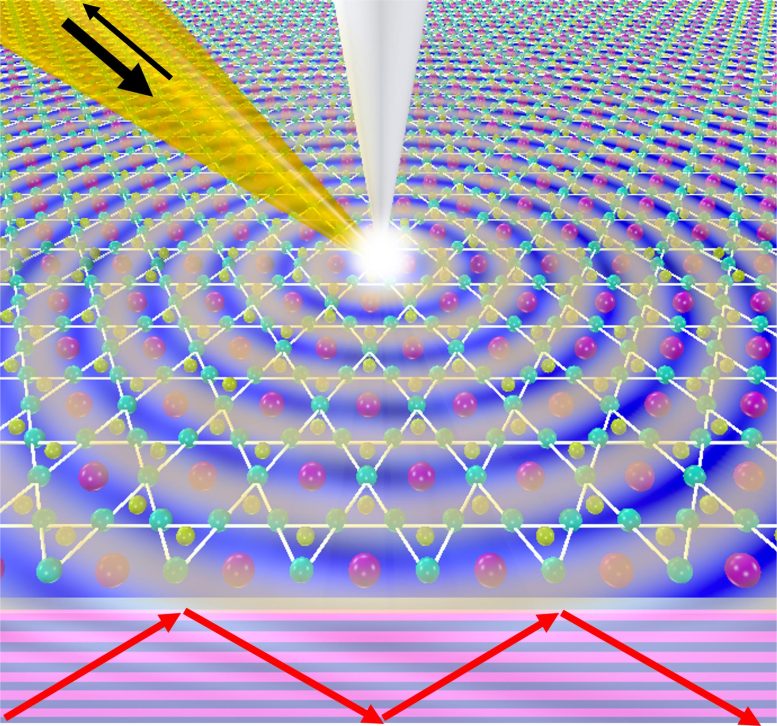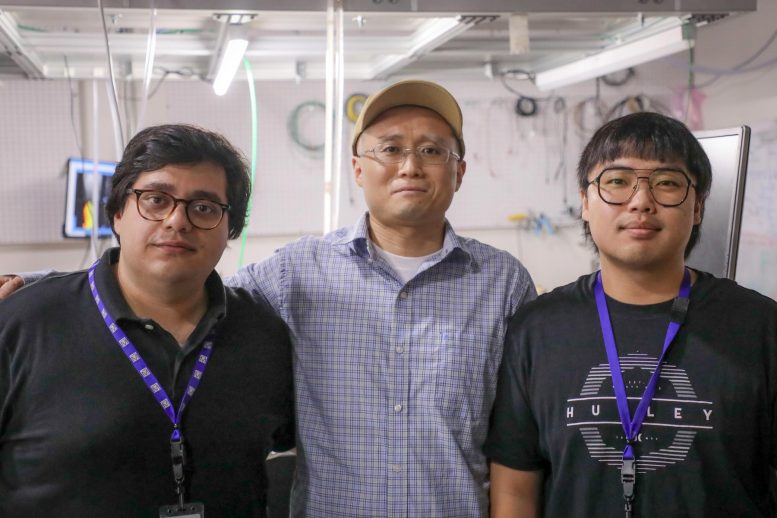
A study focused on cesium vanadium antimonide, a Kagome metal, has shown its potential in enhancing nano-optics by generating unique plasmon polaritons. These findings could advance optical communication and sensing technologies.
In traditional Japanese basket-weaving, the ancient “Kagome” design, notable for its symmetrical arrangement of interlaced triangles with shared corners, graces many handcrafted items. Similarly, in quantum physics, scientists use the term “Kagome” to refer to a category of materials whose atomic structures mimic this unique lattice pattern.
Since 2019, when the latest family of Kagome metals was discovered, physicists have been working to better understand their properties and potential applications. A new study led by Florida State University (FSU) Assistant Professor of Physics Guangxin Ni focuses on how a particular Kagome metal interacts with light to generate what are known as plasmon polaritons — nanoscale-level linked waves of electrons and electromagnetic fields in a material, typically caused by light or other electromagnetic waves. The work was published recently in the journal Nature Communications.
Properties and Photonic Potential of CsV3Sb5
Previous research has examined plasmons in regular metals, but not as much in Kagome metals, where the behavior of electrons is more complex. In this study, the FSU researchers examined the metal cesium vanadium antimonide, also known by its chemical formula CsV3Sb5, to better understand the properties that make it a promising contender for more precise and efficient photonic technologies.
The researchers identified for the first time the existence of plasmons in CsV3Sb5 and found that the wavelength of those plasmons depends upon the thickness of the metal.

Advancing Nano-optics with Hyperbolic Plasmon Polaritons
They also found that changing the frequency of a laser shining at the metal caused the plasmons to behave differently, turning them into a form known as “hyperbolic bulk plasmons,” which spread through the material rather than staying confined to the surface. As a result, these waves lost less energy than before, meaning they could travel more effectively.
“Hyperbolic plasmon polaritons are rare in natural metals, but our research reveals how electron interactions can create these unique waves at the nanoscale,” Ni said. “This breakthrough is key for advancing technologies in nano-optics and nano-photonics.”
Research Methods and Observations in Nano-imaging
To explore how plasmons interacted with the metal, the researchers grew single crystals of CsV3Sb5 and then placed thin flakes of the material onto specially prepared gold surfaces. By using lasers to perform scanning infrared nano-imaging, they observed how the metal’s plasmon polaritons — waves of electrons interacting with electromagnetic fields — changed in interesting ways.
“What makes CsV3Sb5 interesting is how it interacts with light on a very small scale, what’s known as nano-optics,” said lead author Hossein Shiravi, a graduate research assistant at the FSU-headquartered National High Magnetic Field Laboratory. “We found that over a wide range of infrared light frequency, the correlated electrical properties within the metal triggered the formation of hyperbolic bulk plasmons.”
That hyperbolic pattern means less energy is lost. The team’s findings reveal new information about the way Kagome metal CsV3Sb5 behaves under various conditions, providing researchers with a more accurate picture of its properties and potential real-world applications.
Potential Applications and Future of Kagome Metals
“Hyperbolic plasmon polaritons can offer a range of amazing nano-optical features and abilities,” Ni said. “They have the potential to boost optical communication systems, allow for super-clear imaging beyond current limits and make photonic devices work better. They could also be useful for sensing things like environmental changes and medical diagnostics because they react strongly to their surroundings. These qualities make them key for advancing future optical and photonic technologies.”
The CsV3Sb5 metal was a promising choice for plasmon research because of its unusual electronic and optical properties, such as its potential ability to force waves of plasmons to move in a single direction, to name just one. Recent advances in imaging technology at the nano-scale level helped the researchers complete their work.
“Electronic losses typically encountered in conventional metals have previously complicated efforts to observe exotic light-matter coupling effects, including hyperbolic polaritons,” Ni said. “This is part of what makes this an exciting breakthrough. It will be interesting to continue exploring nano-optical phenomena in unconventional metals owing to their potential to contribute to future technologies.”
Reference: “Plasmons in the Kagome metal CsV3Sb5” by H. Shiravi, A. Gupta, B. R. Ortiz, S. Cui, B. Yu, E. Uykur, A. A. Tsirlin, S. D. Wilson, Z. Sun and G. X. Ni, 25 June 2024, Nature Communications.
DOI: 10.1038/s41467-024-49723-x
FSU graduate student Aakash Gupta was also a coauthor on this study. The study was conducted in collaboration with researchers from the University of California Santa Barbara, Oak Ridge National Laboratory in Tennessee, Tsinghua University in China, and Germany’s University of Stuttgart, Leipzig University, and Institute of Ion Beam Physics and Materials Research. At FSU, this research is supported by funding from the U.S. Department of Energy and National Science Foundation.
1 Comment
Electronic losses typically encountered in conventional metals have previously complicated efforts to observe exotic light-matter coupling effects, the hyperbolic pattern means less energy is lost.
Ask researchers to think deeply:
1. What is the basis of coupling effect?
2. Why does the hyperbolic pattern means less energy is lost?
3. Can the universe write function formulas?
4. What is the physical meaning of a function formula or hyperbolic pattern?
5. What is the physical reality described by quantum theory?
6. Can quantum theory describe the superposition and entanglement of topological vortices?
7. Is the superposition, deflection, and entanglement of topological vortices a physical reality?
8. Is the spin of topological vortices left-handed or right-handed?
9. Why modern physics would rather discuss a cat than topological vortices?
10. Can topological vortices be a physical reality of quantum theory?
11. Is quantum high-dimensional spacetime matter or low dimensional spacetime matter?
12. How is quantum gravity formed?
13. How is universal gravitation formed?
and so on.
Spin is crucial in the evolution of spacetime motion of cosmic matter.
Based on the ideal fluid physics characteristics of space, there is no eternal mass, but eternal fluid mechanics. In the interaction and balance of topological vortex fractal structures, spin creates everything (including gravity), and spin creates the world.
The universe does not make algebra, formulas, or fractions. The universe is a superposition, deflection, and entanglement of geometric shapes, is the interaction and balance of countless topological vortex fractal structures. In these interaction and balance, the past is difficult to change. For the future, some predictable, some unpredictable. But, the present moment is real, certain, and actionable. Physics should not ignore that low dimensional topological fractal structures are the material basis of high-dimensional spacetime.
Scientific research guided by correct theories can help humanity avoid detours, failures, and pomposity. Please witness the exemplary collaboration between theoretical physicists and experimentalists (https://scitechdaily.com/microscope-spacecrafts-most-precise-test-of-key-component-of-the-theory-of-general-relativity/#comment-854286). Some people in contemporary physics has always lived in a self righteous children’s story world. Whose values have been overturned by such a comical and ridiculous reality?
Misguided by the pseudo-scientific theory of Physical Review Letters (PRL), many researchers do not consider the similarities and differences between geometric shapes and physical reality in physics research, but indulge in imagination, and some scholars’ physics research seriously deviates from science, and they are almost unaware of the dirtiness and ugliness. Although mathematics is the language of science, it must be understood correctly.
I hope researchers are not fooled by the pseudoscientific theories of the Physical Review Letters (PRL), and hope more people dare to stand up and fight against rampant pseudoscience.
The so-called academic journals (such as Physical Review Letters, Nature, Science, etc.) firmly believe that two high-dimensional spacetime objects (such as two sets of cobalt-60) rotating in opposite directions can be transformed into two objects that mirror each other, is a typical case of pseudoscience rampant.
If researchers are really interested in Science and Physics, you can browse https://zhuanlan.zhihu.com/p/643404671 and https://zhuanlan.zhihu.com/p/595280873.